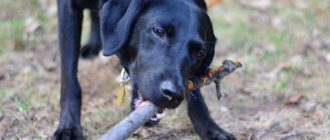If you are thinking about how to teach a dog to swim, first of all you need to understand whether the pet himself wants it. Some four-legged animals are afraid of the water element. They refuse to walk in the rain and, only when they see a puddle, they try to get around it as far as possible. In this case, you need to decide: “Is it worth further traumatizing the psyche of the watchdog, who is terribly afraid of water?”
But many tailed animals love to jump around in the country under running water from a watering hose and “bite” it. They enter the water with curiosity, but categorically refuse to go to the depths, because they are afraid of new sensations or cannot stay on the water at all. What to do? How can you help your beloved friend cope with his fears? More on all this further in order.
Can all dogs swim?
There is an opinion that absolutely all dogs should be able to swim from birth. But it is not so. Yes, swimming is an instinct. Once in the water, the dog will begin to move its paws and try to swim.
There are many breeds that were bred exclusively as hunting dogs and were used to pull prey out of the water. These are breeds such as retriever, Portuguese water dog, Newfoundland, spaniel and others. Many of them love to swim and float perfectly on the water. But even if you, for example, have a retriever, this does not mean that he should love to swim.
For other breeds of dogs, the inability to swim is explained by the physiological characteristics of the structure of the body. Short legs, flattened muzzle, massive chest and light pelvis, long and thick hair. These include such breeds as: bulldog, dachshund, pug, Scotch terrier, greyhound, basset, Pembroke Welsh Corgi, Shih Tzu, Pekingese.
Without special swimming devices, it will be difficult for these sands to stay afloat for a long time. For example, one of the excellent tools is a special life jacket for dogs, which is used both for learning to swim and to help the pet stay on the water longer.
Selection of detergents for dog skin type
The question may arise - how to wash a dog if there is no shampoo? Everything is simple here - you can use baby shampoo with a sufficient content of lecithin and lanolin. If you don’t even have baby shampoo on hand, rinse your pet’s skin with plain warm water.
Animals that have rolled around in dirt or garbage should never be washed with soap! It is better to break the egg yolks into the water and mix them thoroughly. Use the resulting mixture as a rinse, thoroughly massaging the skin and then rinsing it off with a stream of water.
Attention! If your dog's coat becomes dull, this is the first sign that the detergent you are using is not suitable for your pet.
Dog smell - how to get rid of odor
How to wash a dog so that it doesn’t smell like a dog is another pressing question that arises for many dog breeders. You should immediately take into account that healthy pets will not smell, since this is unnatural in nature for a predator. The appearance of an aroma is a signal of poor (incorrect) care for the dog.
Tip: Do not spray your dog with perfume or deodorant! These manipulations can not only ruin the animal’s fur and harm the skin, but can also easily deprive the pet of its sense of smell!
To get rid of dog smell, it is recommended to perform the following manipulations:
- Regularly wash the rug on which your puppy sleeps (at least once every two weeks);
- Constantly wipe the place where the dog rests;
- Stress – out of fear, a puppy can secrete a special secretion that will only increase the level of unpleasant aroma;
- Constantly monitor the condition of your dog’s ears – just enough of them for the aroma to spread throughout the entire room;
- Monitor the condition of the coat. Constantly comb out excess fur;
- A pet diet can solve the problem. Eliminate all junk food from his diet. If the amber disappears during proper nutrition, it means your pet is allergic to some product;
- To eliminate a weak unpleasant odor, special dog perfumes are sold;
- You can also get rid of ambergris by wiping the dog’s fur with a solution of water and vinegar. Remember, the procedure should not be repeated more than once a month.
Pay attention to such a factor as the use of dog deodorants - by masking the aroma, you can miss the manifestation of symptoms of possible diseases. If nothing helps and the unpleasant dog smell remains? Are symptoms of the disease starting to appear? Let's take our pet with us and hurry to the veterinary clinic! You won’t be able to make a diagnosis on your own, but an examination will help you avoid the development of the disease. Now it will be easy to bathe your dog. Following the simplest rules for caring for your “baby” will avoid many problems, while the dog will be clean, tidy and energetic.
Currently reading:
- Is it worth it or not to include natural food in your dog’s diet?
- Seven Signs and Remedies for Getting Rid of Fleas in Dogs
- Games to choose for training a dog
- The American Cocker Spaniel is an adroit hunter and loyal friend.
When to start training
You can accustom your puppy to swimming in open water only after all the necessary vaccinations have been completed and quarantine has been completed. And this is not earlier than the baby reaches 4 months of age!
If you are really impatient, before this time you can begin your first lessons in teaching your dog to swim at home, in the bathroom. Fill the bathtub with water and, very carefully, holding the belly, lower the baby into it. To create excitement and an incentive to swim, place your favorite toy that does not sink on the opposite edge of the bathtub.
Jack, for example, loves ducks like these.
Of course, this is not the same duck that he had as a child. But his love for waterfowl is strong to this day!
Praise the fluffy, give him a treat after the lesson so that he has only positive associations from the whole process.
Preparation
Many dogs enjoy going into the water. Our Jackusik, for example, immediately liked the water element. I was lucky that I didn’t have to beg or teach him. As soon as he entered the water, he realized that it was his!
Most likely, I chose the right place, time and approach to the baby. And now, looking at the pleasure with which he swims, sometimes it even seems to me that in a past life he was a dolphin or a duck!
When preparing your dog for swimming, your task is not to scare the baby, but to arouse his desire and interest in this activity.
And for this you need to know what should be done and what is strictly prohibited.
Absolutely forbidden
Swimming training should be done as a game. Any rudeness or violent step can forever scare away and cause the tailed dog to dislike swimming.
It's better not to do this:
- Do not take water treatments immediately after eating. After eating, at least one to two hours should pass.
- Never lure a four-legged animal into the water by deception.
- Don't pull on the leash trying to force him into the water.
- Do not hold the dog in the water if it panics and rushes to the shore.
- Do not allow your pet to bite the waves or drink water from the pond. This habit can lead to food poisoning or overhydration (excess water in the body). And if it is sea water, then there is a violation of water-salt metabolism. Even if you are in nature, near water, your pet should always have a bowl of clean and fresh drinking water to quench his thirst.
- It is strictly forbidden to throw a dog into the water from the shore or pier. Many people think: “Throw it into the river, and let him get out.” Your instincts will tell you." Yes, most likely the dog will get out on its own. But such an inhumane method will only do harm. The dog will experience stress and horror, and after such a feint, even a cannon shot will not approach the water.
- Do not let your dog into the water wearing a collar: it may get caught on a snag.
- Do not swim in fast-flowing rivers.
- Do not allow your four-legged animal to swim in cold water.
- Beware of steep banks and dirty water.
Place and time for training
If a dog injures its paw with a piece of glass on the very first day, this will darken its joy and craving for water. A couple of years ago, Jack cut his paw badly on the beach. Fortunately, this did not dissuade him from swimming, since by this time he was already madly in love with this activity. But for a whole month he was deprived of the joy of swimming and frolicking with his relatives. I had to walk in socks on three legs and limp.
Therefore, it is important in teaching a dog to swim - it is the choice of place and time. We only need positive associations.
What we do:
- To start training, it is advisable to choose comfortable warm, not very hot weather. Under the scorching rays of the sun, the wet fur becomes very hot, and the four-legged one instantly gets tired.
- The reservoir should be calm, without current.
- Examine the quality of the bottom. Make sure that the bank is not slippery and goes evenly into the depths.
- Make sure there is no glass, sharp stones or snags in the water.
- It is better to choose a place that is not too busy, so that various sounds do not frighten or distract the tail.
Did you plan everything correctly? Now you can start teaching your dog to swim.
Which place to choose?
Find a suitable location. If the dog is small, you can try teaching it to swim in the bathtub. If the breed is large, then choose a body of water. But it should be small, not too deep and not have a strong current and a flat bottom. So, you can come to a small pond or lake. But you should choose a place that is not too crowded, as a crowd of people can further frighten the dog. You can continue training on the river, but choose not wild and dirty beaches, but clean and well-equipped ones, otherwise the dog may get hurt or begin to be distracted by garbage.
Learning process
Where to start?
Start with walking together near a pond. Walk along the shore, get a little closer to the water, wet your paws, run merrily and frolic with your favorite toys. If your baby runs into the water with pleasure, reward him with treats and praise, show him how pleased you are with him. If something doesn’t work out, never feel sorry for the watchdog, don’t make him feel weak and insecure. Only a cheerful attitude and good mood are the key to success.
If the tail happily runs into the water for a toy, you can move on to the next stage.
Go deeper into the water so that the pet is not yet swimming, but is already deep enough in the water, approximately chest-deep. If he stands on the shore indecisively and does not follow you, lure him with a toy or treat. If he categorically refuses to go, stands and barks, don’t make him nervous, it means he’s not ready for this stage yet and it’s better to just continue having fun walks along the water’s edge.
So, the dog came up to you. Take your time to lure him into the depths. Repeat this “entering and exiting” game from the water several times. Get into the water and then have fun running out to the shore together. At this stage of training, he should feel the soil under his paws and the slight pleasant coolness of the water. Ushastik should enjoy new sensations.
Your pet is already easily and joyfully running after you into the water. In this case, we move on to the next stage: we go to depth. If the tail feels insecure and begins to flounder, help him. Gently hold his stomach with one hand, and with the other hold his favorite toy in front of his nose and go deeper and deeper. Once he starts to feel confident, put your hand down and let him swim on his own. Motivate him with a toy so that he swims after it.
Watch your furry pet swim. The head should be above the water. The line of the back is exactly with the line of the water. If your butt is overweight and down, it may be best to use a life jacket at first. All four paws of the pet must be working. If he rows with only two front paws, and the hind paws simply “swim” in a relaxed manner, most likely in this case a swimming vest will help to correct the swimming style.
At first, do not leave the animal even one step. Guide him, correct his movements. If you notice that the swimmer is panicking, immediately hold him by the stomach and direct him into shallow water. Don’t feel sorry for the student, don’t panic yourself. Do everything confidently and calmly. Praise and encourage your dog. The dog should not feel something is wrong and be afraid.
It is best if you do not take off your clothes in the water. Having panicked, the pet may try to climb into your arms and, thereby, scratch you severely.
When your pet is already confident in the water, you can move on to independent water procedures. Throw your favorite self-floating toy into the water. For starters, not far from the coast. Does your dog happily run into the water and bring it to you? Increase the throwing distance, gradually taking the quadruped to depth.
The company of the same four-legged tails stimulates dogs very well. Barbos will not be able to stand still when his brothers are having fun in the water nearby. Of course he will want to join them. Sooner or later, instinct will kick in and your dog will decide to swim. The competition for the fetch thrown into the river works great.
Show your dog a safe way to get out of the water. The four-legged animal must be sure that it can easily and quickly get ashore.
Even if your pet is an excellent swimmer, you must be on alert every minute.
Don’t get carried away yourself and don’t overload your dog. Dogs are like children: their lips will be blue and trembling will run through their bodies, but they still won’t be able to get them out of the water. Yes, the tailed “battery” will tirelessly jump around and demand that you throw a toy or stick into the water. This cannot be done! Be sure to take breaks so that the dog can catch his breath and dry off. One way or another, when a dog frolics in the water, water enters the body, and water intoxication can occur from excessive bathing.
By the way, we are faced with this situation. As I already wrote, Jack simply loves to swim. He will tirelessly jump in the water and demand that they throw him a stick or a toy, and he would swim after it. It is very joyful to watch when your beloved furry is happy. So we got so carried away that we didn’t notice how Jack was clearly overbuying. When he swam for the stick again, I saw that he was barely reaching the shore. Of course, I rushed to help. On half-bent, shaking legs, he crawled out of the water. He was clearly unwell, his stomach was swollen, his tail was between his legs. And then this water just started coming out from everywhere. He was vomiting water. After this incident, no matter how much he demands, we do not allow him to stay in the water for a long time. We alternate between water and sand activities.
Remember that older and pregnant dogs get tired much faster. Therefore, be more attentive to such pets.
If your dog loves to swim, but despite all his efforts, he is not good at it, buy your pet a life jacket. In this vest your little one will feel confident on the water.
By the way, I sewed this cool life jacket for Jack myself. I want to say that if you have at least a little sewing skill, there will definitely not be any difficulties in making it. Especially if you carefully study the material: Do-it-yourself life jacket for a dog.
However, before you go sailing, you need to get your pet used to the new clothes. A few days before you start teaching your four-legged dog to swim, wear a vest at home. The dog will get used to it, and on the water will stop paying attention to him.
If you are unable to teach your dog to swim on your own, you can send him to a special swimming pool for dogs for training. Yes, yes, those exist too. Our friend Patrick learned to swim in just such a pool. That's how it was.
Drying wool after bathing
At the end of the procedure, throw one towel over the dog like a blanket. Blot the wool well so that the water is absorbed to the maximum. Wipe your back, stomach, paws at the very end. Change towels when they get wet. When water stops flowing from your pet, leave the fur to dry naturally.
After washing, the dog is shaken a couple of times, which allows it to get rid of 70% of the water. If your dog is in the room, remove the carpets or take him to a room without them. Otherwise, she will happily wipe herself on the soft surface. For the same reason, keep her away from sofas and beds.
Hairdryer
If your dog is not afraid of a hair dryer, you can use the device. Blow cool air at low speed. Keep the device at a distance of 25 cm. Dry the body with a hairdryer, avoiding the muzzle and paws. At the same time, brush your pet. Do not keep the device in one place for a long time, otherwise the dog may get burned.
Don't forget to praise your baby while drying. If your pet is afraid of a hair dryer, dry it in the traditional way.
How Patrick learned to swim
My mother constantly takes me somewhere to exercise, she wants me to be strong and healthy. I didn't like Agility. There are a lot of dogs there that I don't really like.
Summer was approaching, and my mother and I were planning to go to the sea. It so happens that I love water very much, but I am afraid to swim. So my mother decided to send me to the pool.
We were greeted very warmly there. I was allowed to explore the territory and get used to the trainer and the environment a little. Mom was treated to delicious tea. The environment there is very nice and friendly, I really liked it.
Then we were taken to the pool. He's huge. They put a safety vest on me. The instructor took me in his arms and we began to go down into the water. Mom stayed on the shore.
I was afraid of the first training session. I wasn't interested in balls. I kept looking at my mother with pitiful eyes and trying to taxi towards her in order to “save” in her arms.
But the instructor very competently helped me cope with my fears. After the second training session, I was already actively swimming for the balls and even tried to dive for them without a vest. Yes, I am very brave and courageous! I can do everything!
For good behavior and excellent performance, I was rewarded with a tasty bone and a gift certificate for attending a class in the pool. And my mother was given a calendar in which I was the symbol of the month of April. That's how I learned to swim!
Even if your pet doesn’t like water treatments, don’t be upset. Walking together by the water is also wonderful. And then, there are a lot of other sports that your tail will like, and he will achieve good results in them.
What to do?
How to teach a dog to swim? You should act methodically and gradually. Here are some basic steps:
- First, simply introduce your dog to the water. Take her to the pond, show her that it is not scary at all. Fill your hand with water and let your pet take a closer look. Wet your hand and pet your pet, try spraying it a little.
- Take your pet in your arms and go into the pond with him. Gradually lower yourself until the water touches the dog's fur.
- Place your pet on the shore and gradually lead it into the water. It is better to use a leash to control the situation. Next, take your pet deeper so that the water reaches his chest.
- Move deeper and hold your pet while moving him forward. Instinctively, he should begin to move his paws. Continue in the same spirit, and when you are sure that everything is working out, try removing your hands and letting the dog swim on its own.
- Move away and call your pet to you so that he moves in this direction.
- Next, you can try throwing a toy into the pond so that your pet tries to enter the water without you. But don't move away from him!
- Start swimming longer distances.











